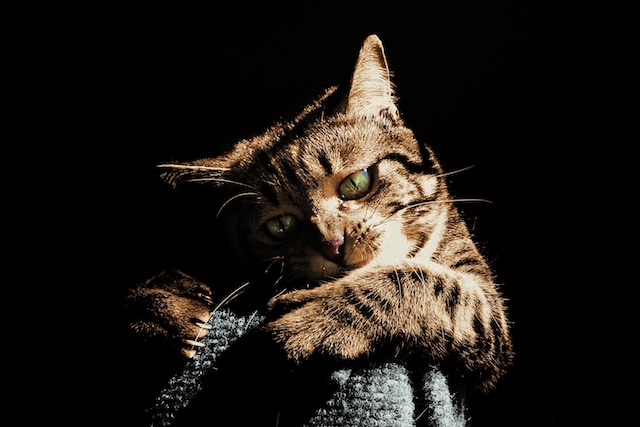Your cat is awake sometimes when you are not. She seems to be able to tell right where you are in your bed to rouse you. (See Ask A Vet: My Cat Wakes Me Up At Night. What Can I Do?)
Could it be that it is because she can see even when you can’t? Can cats really see in the dark?
No animal can see in complete darkness because the structures of every eye depend on the presence of some light, but cats can see better in lower light conditions than humans can. Cats, by necessity, need to be able to hunt in low light conditions. In fact, cats are considered crepuscular which means that they are most active during dawn and dusk. This tendency is believed to be an adaptation to make cats active at times when other predators (that might prey on them) are not as active.
Cats’ eyes are better adapted for lower light conditions than ours are. Most mammalian eyes have two types of cells: rods and cones. The rods process particles of light and pass on the information to the brain in the form of chemical or electric signals. They do not process color vision. Cones are the other vision-associated neurons in the eye and they are active at higher light conditions and they do process color. Cats have more rods than humans, so it would stand to reason that they would be better able to discriminate objects in lower light.
The rods in the back of a cat’s eye are not the only feature that can help feline vision in low light. In order for images to be processed, the light has to reach the rods in the retina. We all know that the pupil of a cat’s eye (and also our own) can open more widely in lower light and close more tightly in bright light. A cat’s pupil can make these adjustments very rapidly, so in lower light conditions, a cat can rapidly adjust to maximize what little light there is.
If you have seen an animal in the shadows with your headlights at night, you know that the eyes can look like levitating green orbs. This phenomenon is because there is an area at the back of many animals’ eyes that reflects light called the tapetum lucidum. It can reflect ambient light and allow the photoreceptor cells another chance at the light that they need to process. This additional pass at the light allows for enhanced vision in lower light conditions. Humans do not have a tapetum lucidum, even though we can reflect some light from our eyes back into a camera lens for the “red eye” effect.
These differences in the anatomy of cat eyes can account for their ability to see things we cannot. It is a reminder for us that cats are not just little people and they have different talents and needs. It is up to us to make sure that we honor those differences and enhance their lives as much as they do ours.
Do you love to learn about cats? I love to post about them! Find me on Facebook by clicking here.



